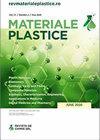Experimental Study on Mechanical Properties of Polyurethane Cement Composite (PUC) Under Various Temperatures
IF 0.6
4区 材料科学
Q4 MATERIALS SCIENCE, MULTIDISCIPLINARY
引用次数: 0
Abstract
This paper aims to investigate the mechanical properties of polyurethane cement (different ratios) at different ambient temperatures. The temperature and proportion which affect the constitutive relation of the material were analyzed by axial tensile test. The microstructure and failure mode of polyurethane cement were studied using scanning electron microscope technology. At -40oC ~40oC, the stress-strain curves of polyurethane cement with different proportions were roughly similar. When the temperature was higher than 40oC, with the rise of temperature, the ultimate tensile strength of polyurethane cement specimens would decrease but the ultimate strain would increase. When the temperature was lower than -40oC, with the decline of temperature, the ultimate strain and tensile strength of polyurethane cement specimens would decrease. The ultimate stress of polyurethane cement with different ratios was different. With the rise of the proportion of polyurethane components, the ultimate stress would increase but the elastic modulus would decrease. Macroscopically, the failure modes of polyurethane specimens were different with the change of temperature. Brittle fracture occurred at low temperatures. At high temperatures, the specimen did not fracture, but a large number of �V�shaped cracks appeared at the edge. The higher the temperature, the more obvious this phenomenon was. At the microscopic level, the fibers didn t break at high temperatures, and there were obvious cracks and more stubble on the surface of cracks at room temperature.聚氨酯-水泥复合材料在不同温度下力学性能的实验研究
研究了不同配比的聚氨酯水泥在不同环境温度下的力学性能。通过轴向拉伸试验,分析了温度和配比对材料本构关系的影响。采用扫描电镜技术对聚氨酯水泥的微观结构和破坏模式进行了研究。在-40℃~40℃,不同配比聚氨酯水泥的应力-应变曲线基本相似。当温度高于40℃时,随着温度的升高,聚氨酯水泥试件的极限抗拉强度减小,极限应变增大。当温度低于-40℃时,随着温度的降低,聚氨酯水泥试件的极限应变和抗拉强度均降低。不同配比的聚氨酯水泥的极限应力不同。随着聚氨酯组分比例的增加,极限应力增大,而弹性模量减小。宏观上,随着温度的变化,聚氨酯试件的破坏模式有所不同。低温下发生脆性断裂。在高温下,试样未发生断裂,但边缘出现大量“V”形裂纹。温度越高,这种现象越明显。微观上看,高温下纤维不断裂,室温下裂纹表面有明显的裂纹和较多的残茬。
本文章由计算机程序翻译,如有差异,请以英文原文为准。
求助全文
约1分钟内获得全文
求助全文
来源期刊

Materiale Plastice
MATERIALS SCIENCE, MULTIDISCIPLINARY-
CiteScore
1.40
自引率
25.00%
发文量
99
审稿时长
6-12 weeks
期刊介绍:
Materiale Plastice, abbreviated as Mater. Plast., publishes original scientific papers or guest reviews on topics of great interest.
The Journal does not publish memos, technical reports or non-original papers (that are a compiling of literature data) or papers that have been already published in other national or foreign Journal.
 求助内容:
求助内容: 应助结果提醒方式:
应助结果提醒方式:


